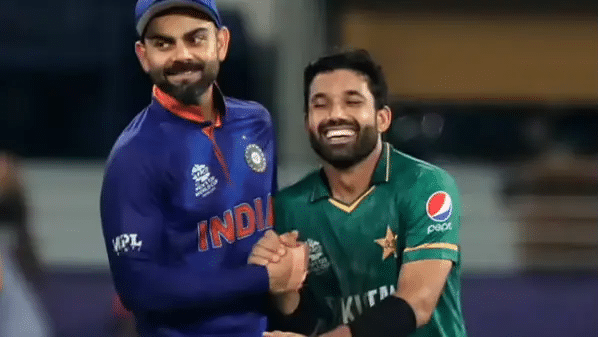With India and Pakistan ready to play for the first time in ten months in the 2022 Asia Cup on Sunday in Dubai, let us take a look back at some of the best India-Pakistan encounters of the twenty-first century.
Tendulkar’s performance
2003 World Cup, Centurion
Indian fans recall that classic slash off Shoaib Akhtar for six over third man when they hear the words Sachin and Centurion. Mostly because it came so unexpectedly early in the chase.
Also read: Asia Cup 2022: Virat Kohli’s top five innings against Pakistan
One shot stood out among the several cuts and drives that pierced Pakistan’s infield with perfection. It was shortly after Abdul Razzaq dropped Tendulkar at mid-off off Akram.
The delivery was similar to the one that had almost caught him: a nice length from over the wicket, angled across the right-hander, almost outside off stump.
Tendulkar glided across his crease with perfect balance this time, shifting weight to his rear foot, and brought down that famously hefty bat to hit the ball and send it screaming through extra cover.
Tendulkar’s swing was flawless, and the boom from the bat was almost as unforgettable as his pull off Andrew Caddick a few days earlier.
Also read: Asia Cup 2022: With revenge in mind, India take on Pakistan
Yuvraj Singh-Shadab Khan
2017 Champions Trophy final, The Oval
Yuvraj Singh epitomised the rise of Indian white-ball cricket in the twenty-first century in many ways: bold all-round ability, athleticism, and, above all, strut. No side felt it more strongly than Pakistan in the mid-aughts.
Yuvraj was nearly done by the time he took the crease in the Champions Trophy final at The Oval – he would only play three more ODIs after this game – but Pakistan would not have known.
Only two weeks before, he’d shown them what he was capable of with a 32-ball 53 in the group-stage hammering. So, when Shadab Khan trapped him in the 13th over with a wonderful, sharp-turning legbreak, it wasn’t simply that the delivery was outstanding – it was.
Also read: India vs Pakistan in Asia Cup 2022: Records, statistics and pitch report
But it was the assurance with which he pointed to the pad and persuaded his captain to study it: “Pad he, pad he, pad pehle he (pad first, pad first),” because he was 150% certain of what had transpired, 150% certain of his skills, and 150% certain of himself, even as an 18-year-old.
That assurance contrasted sharply with the cricket Pakistan normally played against India on similar occasions, when they appeared to shrink. But it was Shadab, the daring all-round talent, athleticism, and, most importantly, strut, who grew. A conclusion and a beginning rolled into one.
Saqlain Mushtaq runs home
1999-2000 Carlton and United series, Gabba
The final ball of the game, one to win. The single had seven fielders on it. Venkatesh Prasad rushes in, doesn’t take a stride, and tries to run out the non-striker, but Waqar Younis, ready to sprint, has his bat in the crease and his gaze fixed on the bowler.
Prasad bowls a slower ball, Saqlain Mushtaq misses wide, and although not stealing ground, Waqar is in the middle of the pitch by the time newcomer wicketkeeper Sameer Dighe gathers and underarms the throw.
Also read: Asia Cup 2022: Bowlers on focus in Sunday’s India vs Pakistan
There are eleven players in one frame. There are nine Indians attempting to make a play at the stumps. Waqar has returned home. Saqlain is standing in the midst of the field, his head turned back, about to realise he is the danger end now that Dighe has missed.
One can imagine India’s captain, Sachin Tendulkar, who is now standing by Saqlain, wishing the ball would hurry up, but it does not. In any case, Tendulkar misses. After scoring the winning run, Saqlain continues to sprint with his bat in the air.
A chaotic conclusion to an old-fashioned ODI on a seaming Brisbane pitch.
The review that lingers
2011 World Cup semi-final, Mohali
The ball had turned beyond the inside edge, hit the front pad in front of middle stump, and the batter hadn’t taken an especially lengthy stride forward. The bowler had released from pretty wide on the crease, creating a big initial inward angle, and the ball twisted and still had a fair distance to travel, which is why Hawk-Eye predicted it would have missed leg stump.
Also read: Asia Cup 2022 India vs Pakistan: Squad T20 stats and records
A sensible on-field decision that was legitimately reversed. One of the many reasons cricket is so beguilingly beautiful is that both of those things are feasible.
But this was Saeed Ajmal to Sachin Tendulkar in a World Cup semi-final between India and Pakistan, so it wasn’t just another perplexingly gorgeous moment. It became the stuff of conspiracy theories, with history and geography playing a role. As well as fate.
Tendulkar was on 23 and batting calmly and confidently. Then came this ball, and the rest of his inning was a battle. He continued to offer chances, and Pakistan continued to shell them. He scored 85 points. India was victorious.
Tendulkar needed to win the World Cup. Everything would fall into place to make it happen.
Also read: Asia Cup: How previous India vs Pakistan matches ended
Mohammad Asif in full swing
2007 World T20 group game, Durban
The final nearly consigns this game to the dustbin of history, but the India-Pakistan group stage encounter offered admirers of Mohammad Asif the wistfully nostalgic hit that only he can provide. Asif bowled first and had India toast in a spectacular opening spell, despite his lack of experience in the shorter format.
There is no love lost between Gautam Gambhir and Pakistan, as Asif sent him back for a duck with a brilliant catch off his own bowling just three balls in. The following three dismissals, however, were typical Asif – Test match balls on a T20 pitch. They all swung in viciously, nearly defying physics, and Virender Sehwag, Yuvraj Singh, and Dinesh Karthik had no answer.
He was allotted four overs and made the most of them. He waved Karthik off to the pavilion, his arrogance and swagger in full flow at the finish. At 36 for four, Pakistan supporters were on their feet, and India supporters were on their knees. Asif had made it feasible for Pakistan to win its first World Cup.







